Grouping students for literacy centers is like trying to solve a wacky math problem on a standardized test:
Sally can’t be in the same group as Johnny. Johnny can’t be with Juan. Juan needs to be with Sally. Matt and Christina should be in the same groups. What group should Riley be in?
Ha. But seriously, I’ve tried quite a few different strategies for grouping. I’ve tried:
- Same-ability groups
- Mixed-ability groups
- Student-selected groups
- Teacher-selected groups
- Smaller groups
- Larger groups
You name it, I’ve probably tried it.
All of that experimentation did lead somewhere, fortunately. I eventually came up with a way to group students for literacy centers so that:
- Students can learn from each other in mixed-ability pairings
- Students also have opportunities to work on the same skills with their same-ability peers
- I can pull students from different groups (for guided reading with me) without messing up a centers activity
In this post, I’ll share how I do it!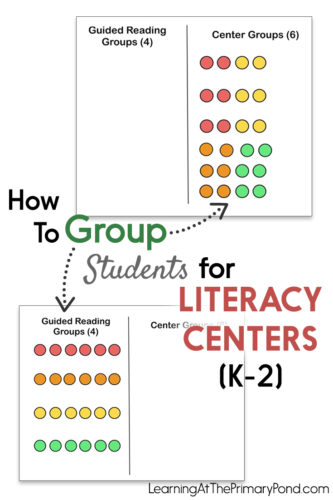 My Goals
My Goals
After some experimentation, I decided that I wanted students to sometimes work with their same-ability peers but sometimes work with different-ability peers.
To play a word work game, for example, it’s easiest if students are working on similar words.
For partner reading, however, it can be beneficial to have a slightly stronger reader working with a slightly lower reader.
I also wanted to be able to pull students for guided reading without it affecting students’ centers activities.
How I Worked It All Out
Here’s what I came up with:
- 6 classroom centers (more about that in next week’s post)
- Activities that require students to work independently or with one other person (to keep noise levels low)
- Groups of 4 or 6 students per center (this is the total number of students in the center—but students typically work in partnerships or alone)
- Center groups that combined pairs of students from different guided reading groups (i.e. 2 students from guided reading group A and 2 from guided reading group C)
Let’s look at an example. In this example, I’ll use ideal, “pretty” numbers, but then I’ll get into some suggestions for making this work with odd numbers or different group numbers.
In your class, you have 24 students. You have 4 different reading groups. They are color coded from lowest to highest, red to green:
You want to make groups of 4 children for your 6 different centers (4×6=24). So you form your groups by pulling together pairs of children from different guided reading groups. You pair together students from groups with different ability levels, but not TOO wide of a gap: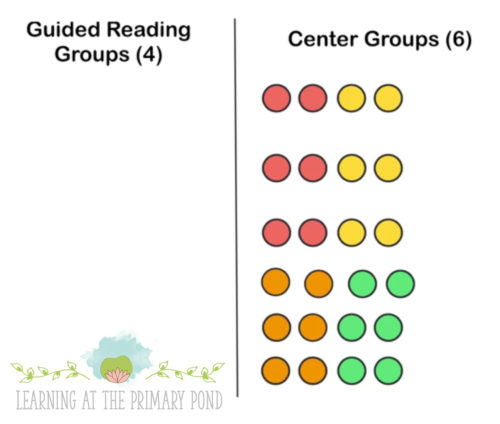
Kids rotate through centers in these groups. In some centers, you tell kids that they should work with a person who is in a different reading group. In other centers, you tell kids to work with a partner from their same reading group.
Whenever you call a guided reading group to come to your table, two kids leave the group. The remaining two children can still work together if they are working in a partner-driven center. They can join another group or choose an independent activity if someone is absent.
Here’s a video of me explaining all this:
Like I said, the “ideal” numbers in this situation make the strategy easy to use. But you can STILL use it even if your numbers are different!
Here are some suggestions to make this strategy work in a variety of situations:
- Use some group(s) of 6 if you have an odd number of students (or a different number of centers)
- If you have an odd number of guided reading groups, divide a larger group into two subgroups
- Teach students “one person” modifications to each center activity in the case of absences or an odd number of students
Here’s a video of me explaining how I would use this strategy with an odd number of guided reading groups:
You’ll have to think through how it would work in your specific situation—you might want to use sticky notes so you can move kids around as you consider different options.
If you try out this strategy, let me know how it goes!

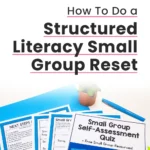
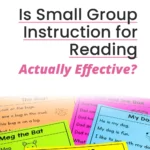
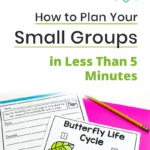
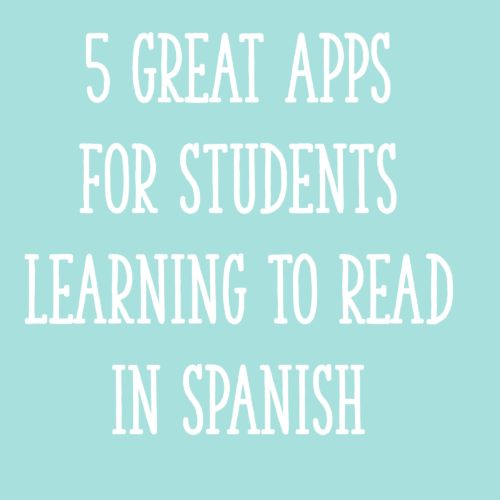

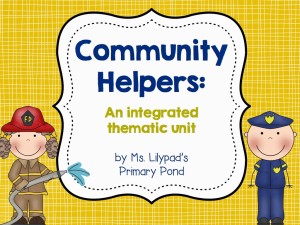






As soon as my new class walks in my room, I start analyzing how to group my students. There are multiple learning styles, personalities, ability levels, English Language Learners from countries globally, maturity levels, special needs, and more to consider. I must say, our world of learners is becoming more complex than ever.
So true! Definitely challenging but a good challenge!
Alison
I absolutely love your ideas and materials!
Thank you so much, Casey!!
Alison
I love this! This is how I group my kids in teams in the class. Groups of 4 – hi with med.low and med.hi with low. So when I saw your diagram, it made perfect sense. Thanks so much for sharing!
Pam
I’m so glad, Pam!! 🙂
Alison
Great idea! Giving it a try Monday morning!
Let me know how it goes! 🙂
Alison
I’ve been watching your webinars & getting some great ideas! Thank you so much!
I’m so glad, Debbie!! Thanks for watching!
Alison
I really appreciate this explanation! I have had a lot of students who work well together but haven’t been at the same reading level. I’ve never been able to figure out how to allow them to partner. I did something similar to this in math last year and as you said, working in partners within groups cuts down on a lot of potential problems. When someone is absent, I typically let the odd student join another pair. Thank you.
Glad to hear you’re able to use something like this in your classroom already!